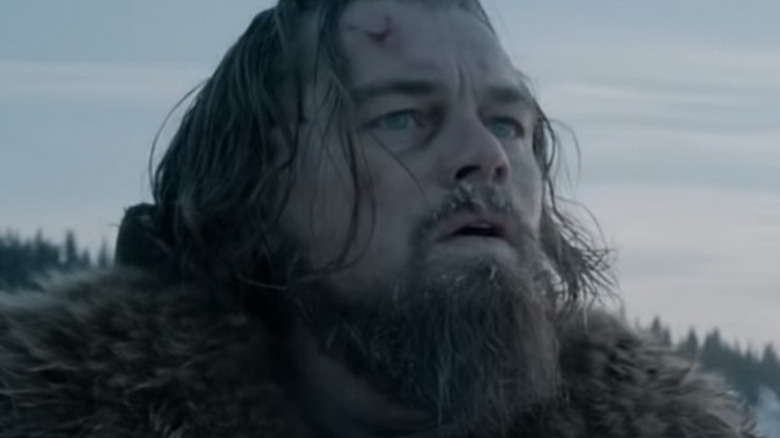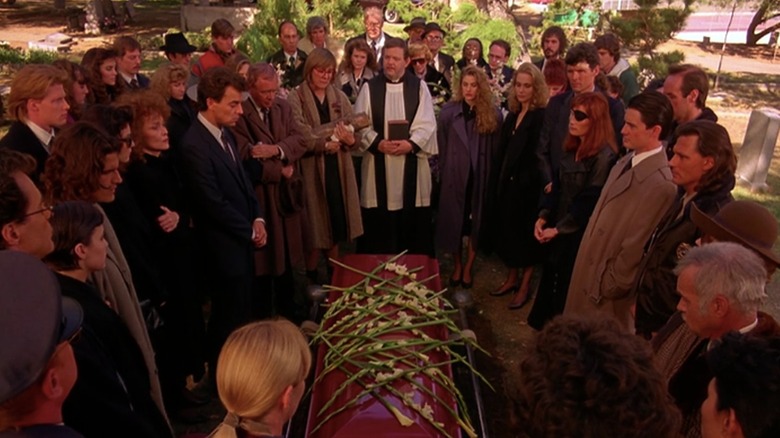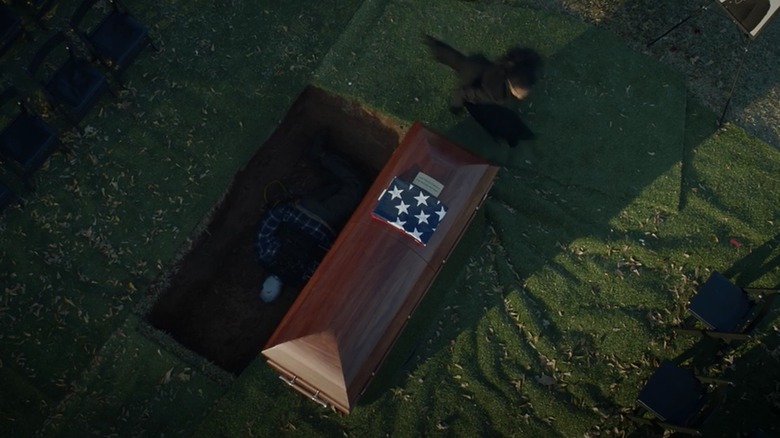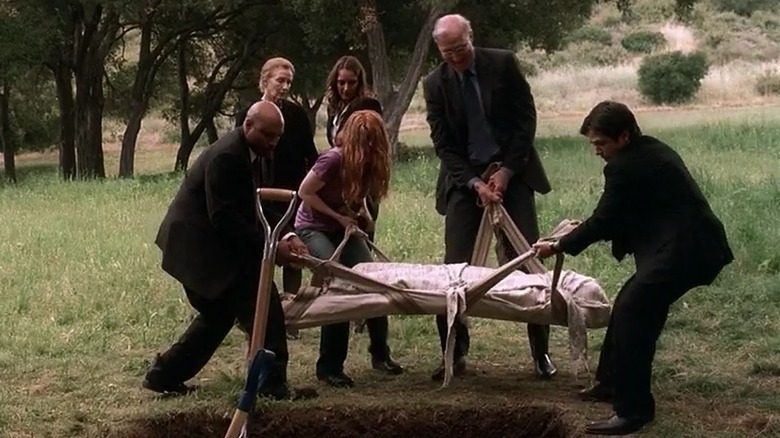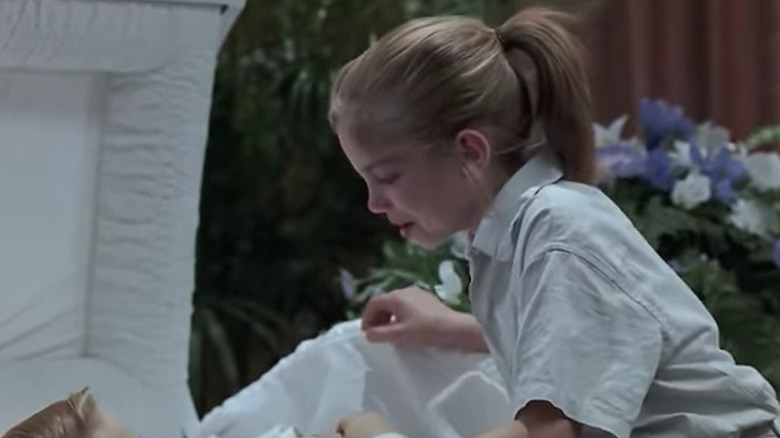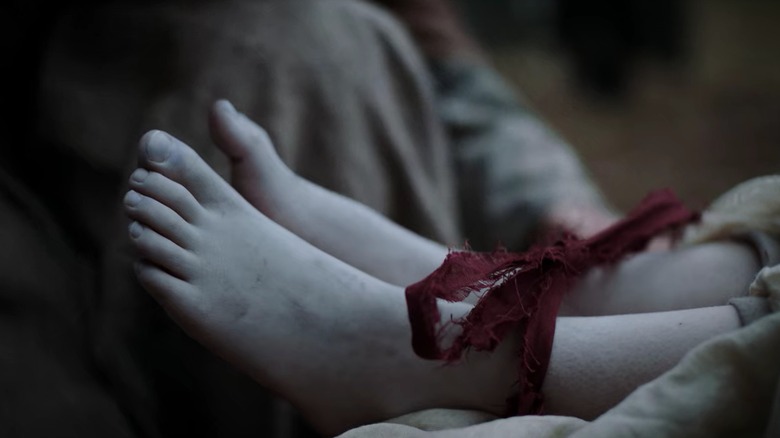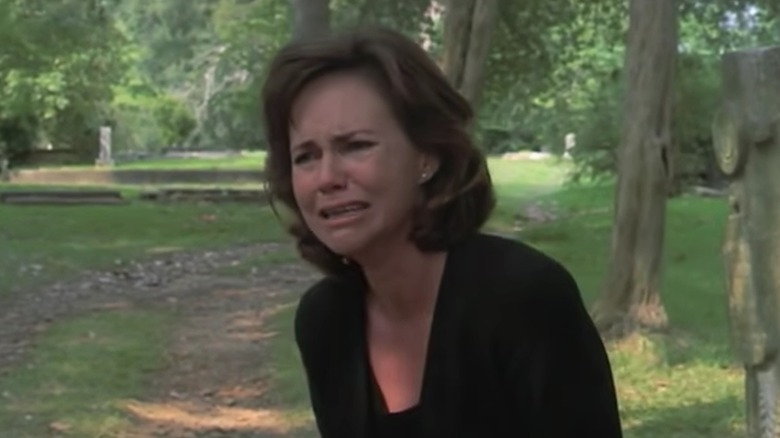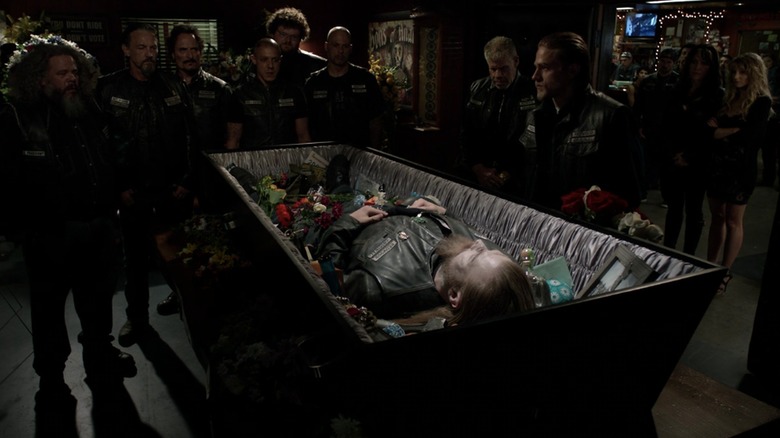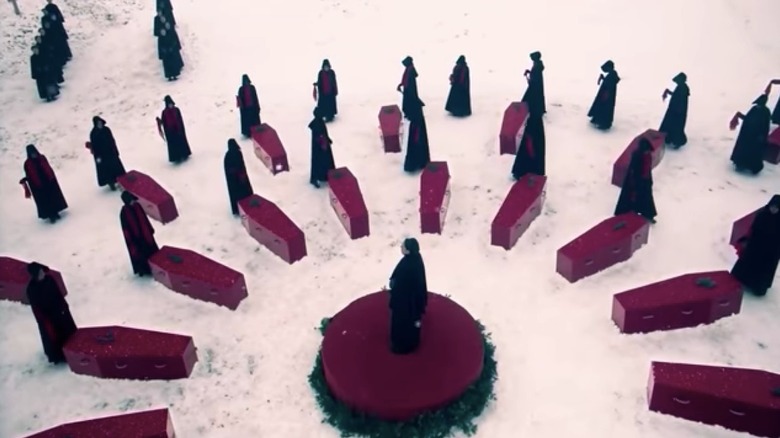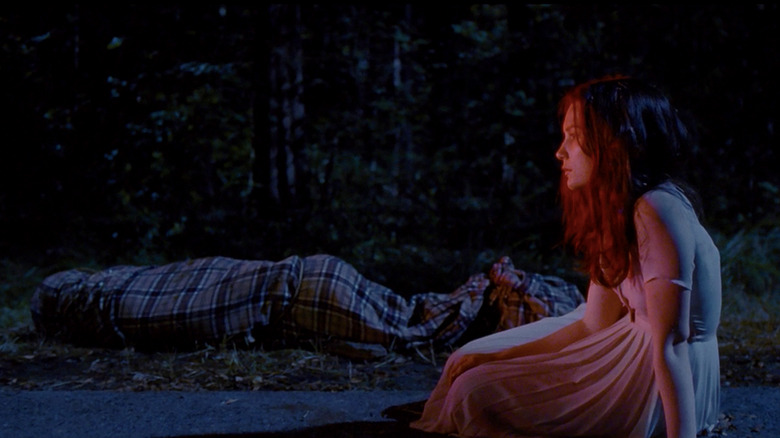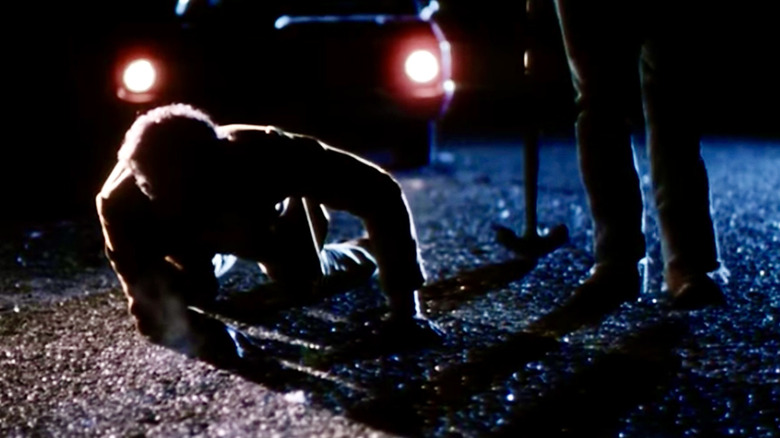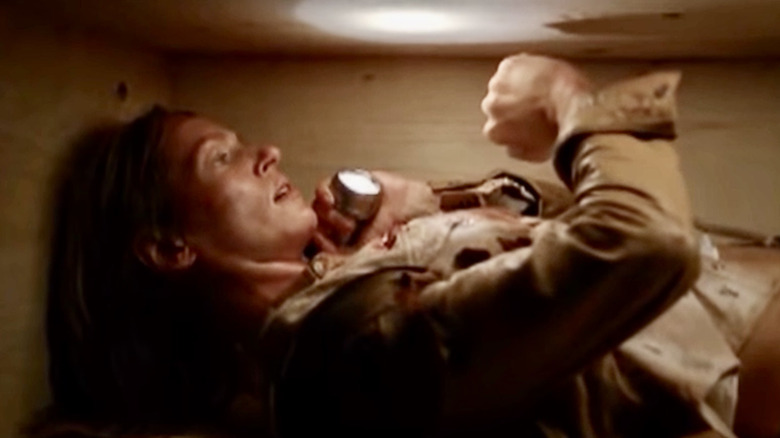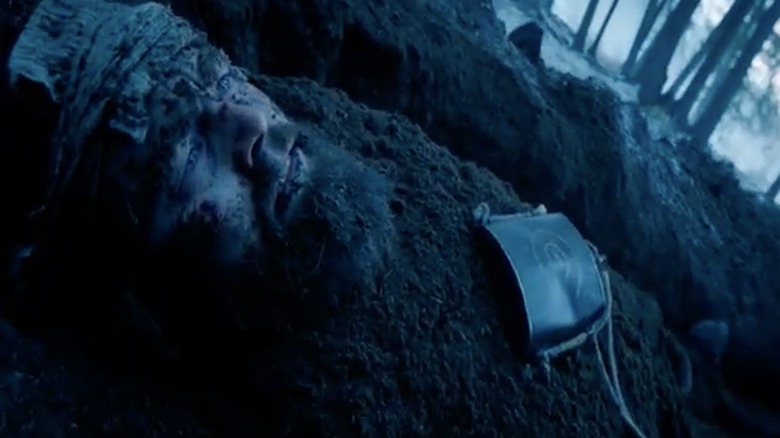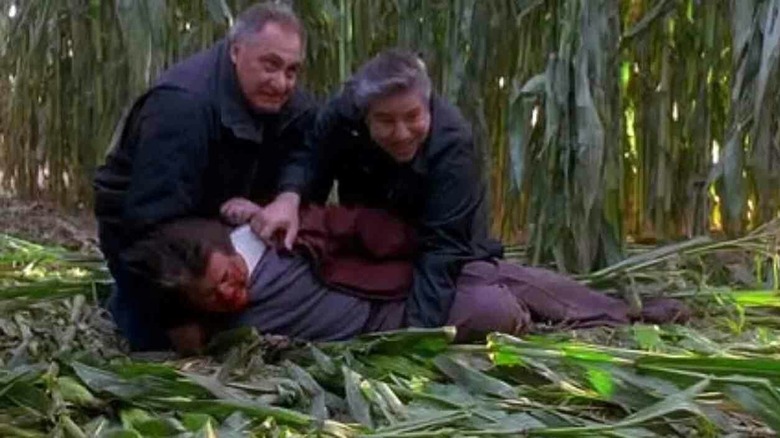TV And Movie Burial Scenes That Went Too Far
Death is something everyone confronts at some point in their lives. We all know someone who has died, and someday we all will die too. But death is also an uncomfortable subject for many of us. A lot of us fear it, and some of us have to deal with death in our work. Because death is such a huge part of our experience of life, it is a common topic in both films and television, and often a huge part of moving the plot forward in many stories. So deaths, funerals and burials find their way into our entertainment. According to Vulture, there is even a cemetery in Los Angeles, Mountain View Cemetery, that specializes in providing film and television productions with a shoot location for burials and graveyard scenes.
Funeral scenes are always emotional, probably because they draw our own experiences with grief to the surface. Some people go to their first funeral as an adult, while others were so young that they may not even remember their first one. A lot of us have a negative memory associated with the first funeral we attended, but many, both fictional and real, blend together. Occasionally we see a burial scene in a film or television series that really stands out, becoming permanently burned into our memory. We've complied a list of television and film burial scenes that perhaps went too far, remaining with viewers years later.
Warning: spoilers ahead.
Twin Peaks (1990–1991)
Laura Palmer's funeral in Season 1, Episode 4 of ABC's "Twin Peaks" was guaranteed to be emotional. When a popular and beautiful young woman is brutally murdered in a small town, you expect a powerful reaction from the close-knit community. Laura Palmer's funeral scene features community grief, public recriminations about who is responsible for her death, and a fight between Laura's boyfriend Bobby and her secret lover James.
Leland Palmer (Ray Wise) then punctuates the chaos of the funeral by throwing himself on his daughter's coffin, sobbing uncontrollably, while his wife Sarah (Grace Zabriskie) yells at him to not ruin the funeral. It is one of the most unsettling such events ever to air on television, inspiring a thread on Quora where one participant called Leland's breakdown "the most disturbing thing to witness ever." It certainly seemed to stick in many viewers' minds.
It's been over 30 years since this series first aired on ABC. According to History, the two-hour "Twin Peaks" pilot premiered with an unprecedented 33% of the television audience watching. The show was an exploration of the dark side of the human psyche, and an example of television audience's appetite for the strange, dark, and mysterious. It was incredibly popular at the time it first aired in 1990, and three decades later this series is still traumatizing, tormenting, fascinating and enchanting viewers.
Watchmen (2019)
HBO's limited series "Watchmen" was a fascinating exploration of an alternate future that, while different from our own, is still plagued by racism, violence, and division, with ties to the generational trauma caused by the bombing of Greenwood, Oklahoma in 1921. In this science fiction series, law enforcement officers in Tulsa wear masks to protect their identities so they won't become targets of domestic terrorist attacks. The story is complex, nuanced and imaginative, centering on a white supremacist group called the Seventh Calvary, and their efforts to maintain political and social power while undermining law enforcement.
In Episode 3 of "Watchmen," the Seventh Cavalry targets the funeral of police chief Judd Crawford, played by Don Johnson, sending a masked assailant with a bomb vest to the funeral. An FBI agent brought in to investigate the chief's suspicious death shoots the terrorist, triggering the timer on the bomb when his heart stops. Angela Abar, played by Regina King, reacts quickly, dragging the body into the grave, then pushing the casket of the deceased chief on top of the bomb to contain the explosion. Angela succeeds in saving the lives of those attending the funeral, but the destruction of the chief's corpse is unsettling.
Perhaps the desecration of a corpse during a funeral, an emotionally loaded and symbolic ritual, makes viewers realize nothing is sacred and no one is safe in a society where violence and hate run wild. This attack may also trigger vague, almost subliminal memories of another historical bombing in Oklahoma carried out by domestic terrorists – the Oklahoma city bombing – that took the lives of 168 people, many of them federal employees.
Six Feet Under (2001--2005)
HBO's "Six Feet Under" was ahead of its time, darkly funny, and surprisingly popular. A series exploring the lives of a family who run a mortuary in Los Angeles is guaranteed to feature a fair number of funerals. But it is the funeral of Nate Fisher, the family's eldest son, that's memorable because it pushed the envelope of what an audience was used to seeing on television.
The burial scene where the Fishers lay Nate to rest was visceral, raw, and not what we have come to expect from burial scenes in television or film. Funerals are, in modern Western culture, a sanitized ritual. A mortician tries to make the corpse look as they did in life. The body is placed in a fancy casket wearing nice clothing, surrounded by colorful flower arrangements. Guests talk about the deceased's wonderful attributes while minimizing their flaws. But Nate Fisher requested a green burial. His body was wrapped in a shroud and placed in the ground without being embalmed or protected by a casket.
Showcasing the incredible acting talents of the entire cast, Nate's burial is an incredibly moving, vulnerable, but brutal scene, as characters who typically approach death with a blasé, desensitized attitude are undone by their grief. Nate's brother David is reduced to a shaking, hallucinating, emotional mess. Their mother, Ruth, seems numb. His sister Claire is underdressed and unprepared. Brenda, Nate's pregnant wife, stands alone, reminding us that ultimately grief is a solitary process and we all mourn in our own way. This burial scene is heartbreaking.
My Girl (1991)
The funeral scene from "My Girl" was absolutely devastating. The 1991 film stars Anna Chlumsky and Macaulay Culkin as childhood best friends during the summer of 1972. In an article on Hello Giggles, the author called the movie, "Heart. Wrenching," a perfect description of "My Girl." Any film where a child (or dog for that matter) dies is hard to handle, but this funeral, where Veda cries repeatedly, "He can't see without his glasses," really pulls at the heartstrings. It is difficult to understand if Veda is just having an emotional breakdown, or if she doesn't understand that Thomas J. doesn't need his glasses anymore.
The film itself wasn't entirely successful in its attempt to explore children's understanding of and feelings about death. The New York Times criticized the film, saying, "The fact that Mr. Culkin dies in this film has been widely publicized, but the circumstances are so farfetched and awful that they defy belief." While some critics didn't appreciate the film on artistic merit, it is one that some of us will never forget, because of the emotional funeral scene near the end of the film — and because it involves someone so young.
The Frankenstein Chronicles (2015--2017)
Netflix's original "The Frankenstein Chronicles" is a morbid, dark and twisty mystery, absolutely worth watching if you have the stomach for the subject matter. Somehow this show straddles the gap between gothic horror and science fiction, much like Mary Shelley's novel "Frankenstein" did. As you can imagine, a series about a sick individual who is building bodies from a collection of parts robbed from graves, attempting to reanimate these grotesque bodies through the use of galvanism, is filled with disturbing imagery and characters.
Perhaps one of the more disturbing scenes in the show comes in Episode 3 of Season 2, when the main character, John Marlott, played by Sean Bean, takes a job delivering corpses from people's homes to a plague pit for group burial. Plague is spreading through London amongst the destitute, who cannot afford a private burial. In this scene, a young girl stoops to tie a red ribbon around the ankles of her dead sister's corpse before the child is placed in a huge open pit filled with bodies wrapped in fabric shrouds. That's to identify her if the family can afford a proper interment at some point in the future. The scene is visceral and disturbing because of how graphic it is, in combination with the knowledge that plague pits actually existed.
Steel Magnolias (1989)
Another intense scene from the big screen was the funeral of Shelby, played by Julia Roberts, in "Steel Magnolias." When Shelby dies from diabetes complications after having a baby against medical advice, her mother M'Lynn's breakdown in the cemetery might be one of the most realistic representations of a mother's grief on film. The pain of having a child who is sick and being powerless to help them or heal them is an unfortunate experience some parents know all too well.
The way M'Lynn, played by Sally Field, goes from bargaining, to anger, and then to hysterical laughter, had an emotional intensity that was palpable. Children aren't supposed to die before their parents, and M'Lynn's anger at this horrible reality jumps off the screen. In a review, Kevin Sessums quoted Bobby Harling, who wrote the screenplay, describing Sally Field's performance on the day of shooting by saying, "She unleashed a tsunami of fear, anger, pain and humanity."
Sons of Anarchy (2008--2014)
When Opie (Ryan Hurst) sacrifices himself in prison for his brothers, "Sons of Anarchy" takes a decisive turn toward its violent conclusion looming in the distance. Although we had seen many deaths by this point in the series, Opie's demise broke some hearts. There was always something forlorn and gentle about Opie despite the violence he was capable of, and the crimes he committed with the Sons of Anarchy Motorcycle Club, Redwood Original (SAMCRO).
Opie's wake was very emotional. The scene starts with Jax sitting on the roof, his go-to spot for introspection, looking at a photograph of him and Opie as children. Later, while the club surrounds the casket, Jax slips the photo into Opie's leather vest over his heart. Opie's widow Lyla stands in the background with club matriarch Gemma as the Sons of Anarchy share a moment of silence over the open casket.
This funeral also signals a shift in Jax and the club. As they try to move away from the criminal activities responsible for the deaths of many members, they keep getting pulled back into crime and the violence associated with it. Perhaps the futility of their efforts to change is foreshadowed by Opie's death. As Tell Tale TV said, "His funeral signals the end of Jax Teller as a level-headed character."
Handmaid's Tale (2017--)
Hulu's original series "The Handmaid's Tale" has won multiple awards and been praised for its astute social commentary and feminist perspective. We are often riveted and traumatized by the action of a single episode because the horrors of Gilead are so beautifully juxtaposed with breathtaking imagery. After the Red Center bombing in Season 2, Episode 6, "First Blood," kills 26 Commanders and 31 Handmaids, Episode 7 features one of the most eerie and beautiful funerals on television.
In a cinematic scene, the surviving handmaids walk through the snow in formation, faces covered, toward a circle of red coffins as a haunting song plays, with the vocalist singing, "My life don't count for nothin." The series often uses music for emotional effect and this is absolutely true for this scene. The funeral of the handmaids is chilling and emotionally intense. As we watch these women laid to rest, it becomes clear that they aren't, even in death, given the dignity of their own names, as Aunt Lydia calls out, "OfRyan, OfLeo, OfBen..." It's a chilling commentary on women treated as possessions in a patriarchal culture taken to a dystopian extreme.
Stoker (2013)
The 2013 film "Stoker" is creepy and disturbing, with a menacing miasma of dread. Uncle Charlie Stoker, played by Matthew Goode, comes home to the family estate after a long absence when his brother dies. Nicole Kidman plays the emotionally arctic widow Evelyn, and Mia Wasikowska is her daughter, India Stoker. The film is flooded with, as film critic Richard Roeper wrote of director Park Chan-wook's first English language film, "unbearable tension, sexual and otherwise." Although Uncle Charlie is charming and polite, there is something unsettling and sinister about him. The mystery of where he has been for the entirety of India's life only heightens the audience's suspicions.
One of the more disturbing scenes in the film is a different kind of burial scene, something more lurid and illicit than a funeral. India and Uncle Charlie kill and bury a local teenage boy after he was sexually aggressive with India in the woods. The murder and burial is cut with scenes of India showering after burying the body. The link created between India's nascent sexuality and the violence is revolting. After these disturbing scenes play out, the audience begins to understand that India might be as deranged and dangerous as her Uncle Charlie.
Blood Simple (1984)
Another truly disturbing burial scene is from the Coen brothers' first feature, "Blood Simple." This neo-noir film is filled with despicable characters, making it nearly impossible for the audience to find somebody to root for. The plot twists and turns, moving forward like a train on a collision course. Equal parts dark comedy and film noir, this story depicts one worst-case scenario leading to another, with much of the film's action due to miscommunication and deception.
The scene one can't shake from "Blood Simple" is when the private detective, Visser, double crosses Marty (the man who hired him). Visser shoots Marty with a gun he stole from Marty's wife Abby, effectively framing her for the murder of her husband. Visser then attempts to bury Marty in an agricultural field, but he just won't stay dead. The shallow grave is lit poorly by the headlights of a car on a desolate road. All you hear are crickets, the scrape of a shovel and Visser's labored breathing.
Marty sits up in his grave, covered in soil, pointing the gun at Visser with a shaking hand, but the chamber is empty. Visser takes the gun away, frantically burying Marty alive as we hear the shovel slapping packed earth. It is a chilling scene that plays with the audience's senses, creating the panic both Marty and Visser must experience during this harrowing experience. The scene is a brutal reminder of how fragile we really are, and how easily we can be killed.
Kill Bill: Vol. 2 (2004)
Tarantino has been sharing his dark imagination with us for decades, often portraying over-the-top, stylized violence. MTV praised "the twitchy visionary's ability to create enduring images of unimaginable brutality." Being buried alive, according to Smithsonian magazine, is a common fear, leading to a sub-industry of specialized coffins just in case one actually does get buried alive. Uma Thurman's character in the Kill Bill movies, the Bride (aka Beatrix Kiddo), experiences Tarantino's brand of brutality when she is buried alive in "Kill Bill: Vol. 2."
Her panic is palpable as the lid of the coffin is hammered into place, strips of light vanishing until she is plunged into darkness. Many complaints about this scene on discussion forums revolve around whether it's actually possible to break out of a coffin and dig yourself out of the grave before running out of air. But even those critical of the scene's believability admit how successful it is at inducing feelings of fright and claustrophobia. As Entertainment Weekly said, "The claustrophobia of interment itself is created with lovingly creepy verve and hideously good sound work."
The Revenant (2015)
Leonardo DiCaprio finally won an Oscar for his role as Hugh Glass, a real-life 19th century frontiersman and fur trapper in "The Revenant." In an interview with Yahoo, DiCaprio said, "I can name 30 or 40 sequences that were some of the most difficult things I've ever had to do." The entire film is intense, immersive and was apparently insane to film. The movie, as discussed in this interview, took a whopping nine months on location in Canada and Argentina to complete.
After a brutal bear attack, Hugh Glass is dragged into a shallow grave by John Fitzgerald, played by Tom Hardy. Glass is partially buried while he is still conscious, and left to die. The scenes of Glass being dragged into a hole in the ground and covered with soil while he groans painfully are terrifying. Can you imagine being injured and vulnerable, having someone you trusted do this to you? Just thinking about it can give you chills. When Glass wakes up in his freezing tomb of dirt, he resolves to find his way back to civilization to enact his revenge on the man who so viciously abandoned him.
Casino (1995)
We've been saving the best, or perhaps the worst, for last. The most disturbing burial scene in cinematic history is arguably from Martin Scorsese's "Casino," a fictional story inspired by true events. Nicky Santoro, played by Joe Pesci, and his brother, Frankie, meets mobsters in an Indiana cornfield, where they are beaten bloody with baseball bats and buried in a shallow grave. It is a traumatizing scene. The brutality of the beating, with realistic sound effects from the impact of baseball bats on their bodies, is bad enough. But the way the brothers are stripped to their underwear and buried while they are still breathing is unforgettable.
Don't lose too much sleep over this scene despite its brutality. The real-life brothers these characters were based on didn't die in a shallow grave in a cornfield. The actual circumstances of their deaths didn't become public knowledge until after the 2007 murder trial, almost a decade after the film was released. The real-life brothers were reportedly lured to a meeting with promises of a promotion within their criminal organization, and murdered in the basement before being transported to a cornfield for burial. Despite this burial scene in "Casino" being fictional, it is still very disturbing.
